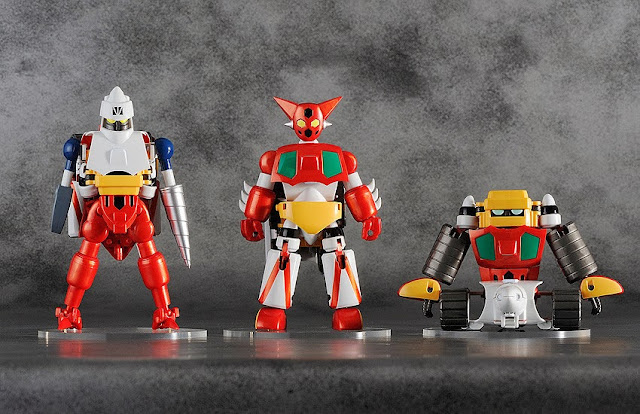Because I live in the U.S. and not Japan, my first introduction to combiner robots came through Japanese toy lines that were imported into the U.S. during the '80s: Gobots, Transformers and Voltron. Since each of these toy lines had its own cartoon series, it was generally assumed that if you saw a group of vehicles or robots combining together to form a gigantic robot in the cartoon, there was also a toy available that could do the same thing. After all, who would taunt potential toy buyers with a cartoon that showed vehicles and robots doing something that their toy versions couldn't do, right?
What I didn't know at the time and only found out recently was that the concept of a combiner robot actually began in the '70 with a manga and anime series called Getter Robo. In Getter Robo, three combat jets would combine together to form a giant robot; depending on the sequence of the jets' combination, a different giant robot would be formed. Getter Robo was very popular and it spawned plenty of merchandise and numerous anime and manga sequels; in fact, these toys were also included in Mattel's Shogun Warriors line.
However, there's a drawback to the first Getter Robo that's peculiar for a Japanese combiner robot: For as ground-breaking as the combiner robot idea was at the time, no one seemed to know exactly how the combat jets could come together to form anything, let alone a giant robot. As you can see from the video clip below, even the animators behind the original anime series had to take significant shortcuts during the jet combination sequences.
From what I can gather, the dominant attitude towards the first Getter Robo toys and model kits is that companies would produce the jets and the giant robots, but they wouldn't produce jets that could combine to form a giant robot. Apparently, this approach worked, but it seems very strange when compared to the countless combiner robots toys that Getter Robo influenced. Subsequent jet and robot designs for most of the sequels were much more detailed and provided clear views of how the jets combine, but the early designs for Getter Robo are astonishingly vague in their combination mechanics.
Of course, if you really, really want to collect toy replicas of the original Getter Robo jets that can combine into various robot configurations, you can--but it will cost you. The Perfect Change Getter Robo set, the most detailed and scale-accurate combining toy based on the original Getter Robo design, costs hundreds of dollars. The cheapest set, Dynamic Change Getter Robo, is a chibi-scale interpretation of the original design and it costs over $100.
The Perfect Change Getter Robo set.
The Dynamic Change Getter Robo set.
The problem with Getter Robo toys sort of reminds me of the Transformers Masterpiece collection. The animators who worked on the first Transformers cartoon took many liberties with the toy robot designs in order to create robot characters, all of the purpose of selling the toys. Now, decades later, Transformers fans can by transforming toy robots that look exactly like they did from the original cartoon from the '80s, but each Masterpiece figure costs several times the amount of a regular transforming toy robot.

Figures from the Transformers Masterpiece collection.



0 comments:
Post a Comment